
Cabannes is a lunar impact crater that lies in the southern hemisphere on the far side of the Moon. The rim has been worn by subsequent impacts, with a smaller crater overlying the southern rim. However the formation has not been significantly reshaped by nearby craters.
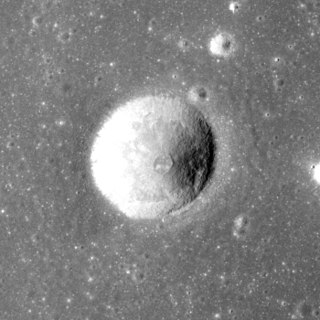
Borel is a tiny lunar impact crater located in the southeast part of Mare Serenitatis. It was named after French mathematician Émile Borel. To the northeast is the crater Le Monnier and to the southeast is the crater Abetti. Borel was previously identified as Le Monnier C.

Deseilligny is a small lunar impact crater in the southern part of the Mare Serenitatis. It was named after French selenographer Jules Deseilligny. It is located to the east-southeast of the crater Bessel. Deseilligny is a bowl-shaped crater with a low rim. It is otherwise undistinguished.

Finsch is a relatively small lunar impact crater in the mid-part of Mare Serenitatis that has been almost completely covered by the mare, forming a ghost crater in the lava plain. It was named after German zoologist Otto Finsch. It is located to the south-southeast of the crater Sarabhai and northeast of Bessel.

Fahrenheit is a tiny lunar impact crater located in the southeast part of the Mare Crisium. This area of the surface is nearly devoid of impact features of interest. To the east are the Dorsa Harker wrinkle ridges, and beyond them is Promontorium Agarum at the edge of the mare. The landing site of the Soviet Luna 24 probe is located about 15 kilometers to the southeast.

Boethius is a small lunar impact crater located on the east edge of Mare Undarum near the eastern lunar limb. To the southwest is the dark, lava-flooded crater Dubyago.

Beketov is a small lunar impact crater that lies in the northern reaches of the Mare Tranquillitatis. It is named after Russian chemist Nikolay Beketov. To the south is the ghost crater Jansen R. Northeast of Beketov, along the edge of the mare, is the crater Vitruvius. Beketov was previously designated Jansen C before being named by the IAU. The flooded crater Jansen itself lies to the south.

Guericke is the remnant of a lunar impact crater at the north part of the Mare Nubium. It is named after German scientist Otto von Guericke. To the north-northwest lies the large Fra Mauro crater, along with the co-joined craters Parry and Bonpland. To the east are the craters Kundt and Davy.

Artemʹev is a lunar impact crater that is located on the far side of the Moon. The rim of this crater has been modified by subsequent impacts in the vicinity, with an inward bulge along the southwest edge and a worn impact lying across the north rim. The satellite crater Artemʹev G is partly overlain by the southeast rim of Artemʹev. The crater interior is relatively flat, and marked only by tiny craterlets.
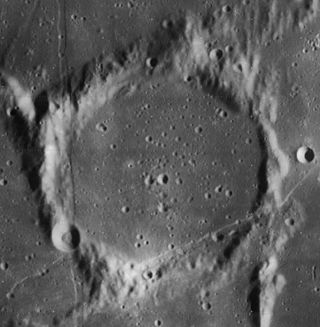
Parry is a lunar impact crater that is attached to the southeast rim of the walled plain Fra Mauro. It was named after British explorer William Parry. Attached to the west and southwest rim of Parry is the crater Bonpland. Due south of Parry is the small crater Tolansky, and farther to the south-southwest is Guericke.
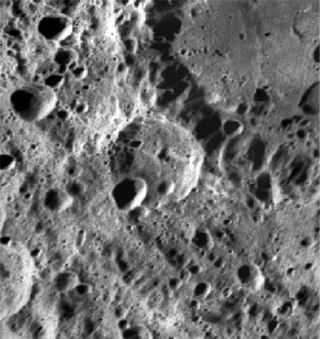
Belyaev is a lunar impact crater that is attached to the outer edge of the Mare Moscoviense, on the far side of the Moon. It is a worn formation with a small crater pair overlaying the southern rim, and several smaller craters across the relatively irregular interior.
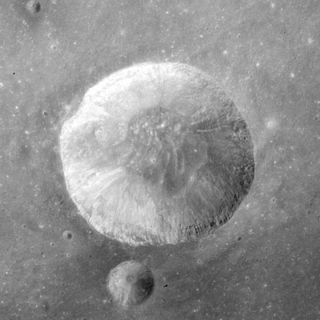
Carmichael is a lunar impact crater that is located along the eastern edge of the Sinus Amoris, in the northeastern quadrant of the Moon's near side. Its diameter is 20 km. It was named after American psychologist Leonard Carmichael. It lies within a couple of crater diameters south-southwest of the smaller crater Hill. Further to the east-northeast is the prominent crater Macrobius. Carmichael was designated Macrobius A before being given its current name by the IAU.

Elmer is a small lunar impact crater that is located to the south of Mare Smythii, near the eastern limb of the Moon. This crater is seen at a highly oblique angle from Earth, and the visibility is affected by libration. Elmer lies southwest of the crater Kreiken, and east-southeast of the larger Dale. This is a circular, bowl-shaped crater with an interior floor that occupies about half the total diameter.

Courtney is a tiny lunar impact crater on the Mare Imbrium, a lunar mare in the northwest quadrant of the Moon. It lies about two crater diameters to the northwest of Euler, in an otherwise isolated stretch of the mare. The dark surface in this region is marked by Euler's ray material. The name is an English male name.

Dove is a small lunar impact crater located in the rugged lunar highlands in the southeastern part of the Moon. It lies to the north of the prominent crater Pitiscus. The crater is named after Prussian physicist Heinrich Wilhelm Dove.
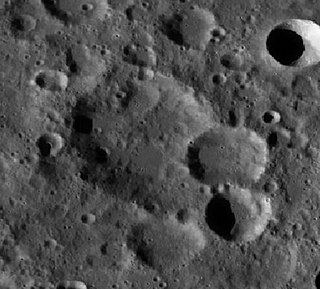
Champollion is a lunar impact crater that lies on the far side of the Moon. It is located north-northeast of the larger crater Shayn, and south-southeast of Chandler.

Charlier is a lunar impact crater that is located on the far side of the Moon. To the south-southeast is the larger crater Kovalevskaya, and northeast of Charlier is Perrine.
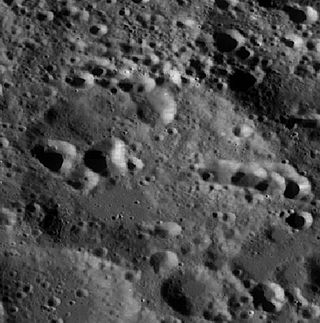
Chandler is a lunar impact crater in the northern hemisphere, on the Moon's far side. It lies to the southeast of the large walled plain D'Alembert, and southeast of the slightly smaller Chernyshev crater.

Fesenkov is a lunar impact crater on the far side of the Moon. It is located to the east-southeast of the prominent crater Tsiolkovskiy, and less than a crater diameter to the north of Stark.

Aepinus is a small lunar impact crater located along the northern lunar limb, close to the north pole of the Moon. To the south east is the prominent crater Hermite.






















